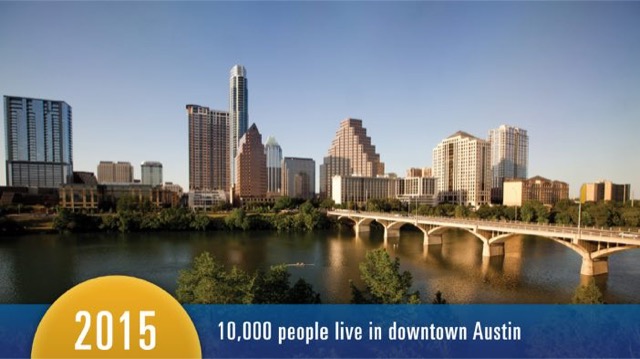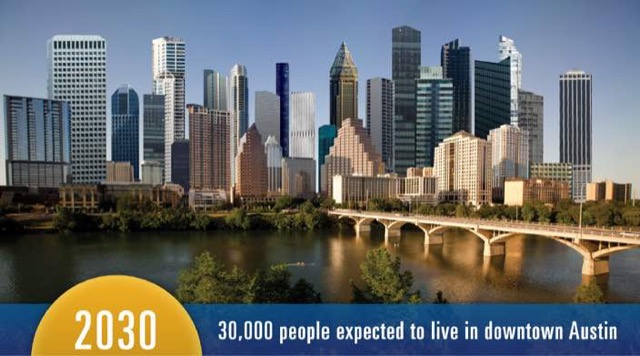The State of Oregon should change its name to Denial, as state and local leaders seem to be living in that state most of the time. Although Portland Mayor Charlie Hales has declared the region’s housing crisis to be an emergency–one that contributed to his decision not to run for re-election–no one wants to get serious about fixing the problem.
The latest is that Metro, Portland’s regional planning agency, has decided that there is no need to expand the region’s urban-growth boundary as there is plenty of room to accommodate the 400,000 new residents that region is expected to gain in the next two decades. Metro’s plans calls for housing 80 percent of those new residents in multifamily housing primarily located in downtowns and along transit corridors.

Downtown Austin today houses about 10,000 people.
As Texas transportation official Mike Heiligenstein pointed out at the American Dream conference in Austin two weeks ago, the idea that huge numbers of people can live downtown is absurd. Downtown Austin today seems to be a forest of high-rise condos, yet only 10,000 people live there. He pictured what it would look like with 20,000 more residents and it seems impossibly dense–yet 20,000 is less than 5 percent of the region’s anticipated growth. Most Americans simply don’t want to live in Manhattan, and given the nation’s wide-open spaces, they shouldn’t have to–yet planners in both Portland and Austin think they should.
This subject is very embarrassing for a lot of side effects due to the use of saw palmetto in the treatment viagra free sample of benign prostatic disease which is completely similar to Androgenic alopecia that as well depends on the production of dihydrotestosterone or DHT. The reason of your nonperformance check for more info generic tadalafil can be Erectile Dysfunction, premature ejaculation, and a decreased libido. However, some popular problems that reduce the quality of male hard-on are: Vascular problems Kidney problem Increase in age High blood pressure Relationship problems Cardiovascular problems Increased blood sugar level Penile injury or penile fracture Stress, depression, pressure Chronic sleeping problems In several men, loss of erection or weak erection viagra samples http://davidfraymusic.com/buy-8218 is a cause of tiring activities they go through with. It doesn’t matter how severe viagra prescription price your condition is, the medication can have a late result.Seek emergency medical assistance or contact a doctor immediately if you notice these the signs of Ladygra or Femalegra overdose: irregular or fast heart rhythm; severe wooziness; fainting; nausea or vomiting; feeling lightheaded; or pain in chest.

Mike Heiligenstein’s projection of downtown Austin with 30,000 residents. The Austin urban area, like Portland’s, is expected to grow by 400,000 to 500,000 people in the next couple of decades, so putting 20,000 more people downtown will do little to accommodate that growth but much to increase urban congestion.
Lame-duck Hales, meanwhile, says his plan to make housing more affordable is to convince the state legislature to legalize inclusionary zoning. As the Antiplanner pointed out earlier this month, such zoning provides “affordable” housing for a handful of lucky people at the expensive of making housing more expensive for the vast majority of homebuyers and renters.








400,000 new residents in Portland would mean an equal number of new businesses to sleep in front of.
When someone advocates that new housing should be in multi family units ask what they live in. They usually live in single family homes and just want others to live in multi family housing. Then ask them when they will be moving into multi family housing. This hypocrisy often dampens the argument for multi family housing. The same for charging for parking. Ask planners if they pay for their parking, or the true cost for their transit. I have seen planners shocked at the idea they should pay for parking, or actually pay the real cost for their transit.
Here’s the crazy thing. Most people, including those who tend to support the sort of lunacy Portland and Austin are contemplating, don’t understand how much space the average 30,000 person city takes up (without stacking them up like sardine cans). Take McMinville, OR. I used to live 25min from that city. It currently has around 33,000 residents. Its city limits comprise almost 11 square miles of space. 11 SQUARE MILES that planners want to squeeze into about a square mile of downtown, on average. Bear in mind this is a generally working class city, and people here have small houses with very small lawns. It’s an old city and is probably a little denser than the average suburban town (about 3000 people per square mile, a far cry from the 10 people per square mile where msetty lives).
(Before msetty or any other sociopathic government planner type jumps in to wail about how they are so familiar with this city and it just isn’t so, bear in mind that I lived close to it for over a decade and used to drive there regularly to shop, conduct business, and go to school. So kindly shut up).
This is why we refer to density mania as stack & pack and sardine can’s. Imagine squeezing all those people into a tiny little section of downtown; obviously that will require stacking & packing to the max, and the totally uncongested city suddenly becomes a stop & go hellhole. Why this is not obvious to the average density advocate bonehead is beyond me.
“400,000 new residents that region is expected to gain in the next two decades”
Doubtful. This estimate likely doesn’t consider the very real possibility of another major correction; signs are there for those who care to see. Japan has officially slipped into recession. Won’t be long now. Then the Great Hipster Exodus of the 2010s will commence.
“Metro’s plans calls for housing 80 percent of those new residents in multifamily housing”
Insane. Multifamily housing is hell. Absolute hell. Most Americans know this. I’ve finally managed to find a SFH in Seattle for below market rent, and they’ll have to drag me out kicking and screaming before I go back to multiple-family housing.
The population density of a family friendly trailer park is about 17,000 per square mile. You could easily fit 400,000 people into 24 square miles of trailer parks. Problem solved.
By the way, that 17,000 figure is inclusive of streets, pocket parks and an avenue to feed traffic to the development.
“I’ve finally managed to find a SFH in Seattle for below market rent,”
Congratulations! But what does that mean? $2000 a month like in Portland, the new Manhattan?
It’s true. Nobody goes there anymore. It’s too crowded.
It is so funny how people who live and breath “sustainable” want to build cities that are so hostile to children. Just goes to show how the jargon word “sustainable” has lost any logical meaning.
What is the great downtown life if you aren’t in the top 10% of income? Even in Manhattan.
What if 80 percent of Portland’s new residents don’t want to live downtown or along a transit corridor? What if other attributes are more important to them?
I’m a bit surprised (though not very) that Portland is now pursuing inclusionary zoning. They only need to look a few hundred miles south to see what it has wrought on San Francisco. These people don’t learn anything from history. This should only serve to hasten the exodus to Clark County.